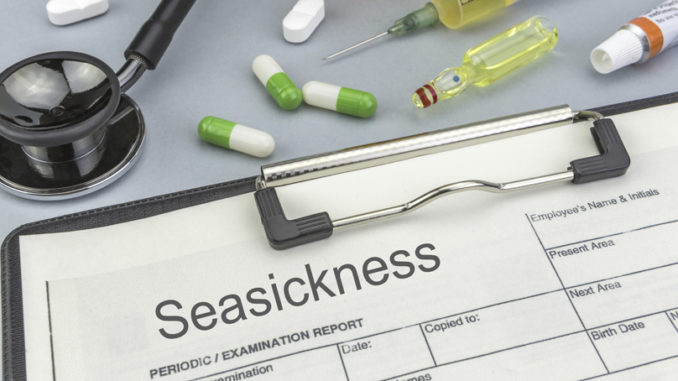
This SCDNR study sheds light on some effective remedies
Earlier this year, we shared five general takeaways from an SCDNR marine staff survey on seasickness.
Now, we’re digging into how those 100 staff members ranked the effectiveness of all the seasickness treatments they’ve tried over the years. Motion sickness pills were the most widely cited method among our staff. But they were not the most effective. If ever you’ve found yourself seasick on the deck of a boat and wondering about better treatment options, read on for more insights.
Most Effective
The patch
Prescription drug scopolamine is generally regarded as the gold standard in reducing nausea and vomiting, whether due to seasickness or opioid usage after surgery. Unfortunately, as many users learn the hard way, the patch also comes with a catalog of warnings.
Scopolamine is commercially available in just one dosage. It’s a one-size-fits-all patch that delivers the same amount of drug whether you’re 100 or 300 pounds (the patch is not recommended for children). The 1 mg dosage may therefore be overwhelming for those on the small or drug-sensitive end of the scale. This often results in side effects that can range from dry mouth to drowsiness to blurred vision and disorienting hallucinations. Many users also experience significant withdrawal symptoms after returning to land and removing the patch. These symptoms can take several days to abate.
Verdict: For long, multi-day trips like our Coastal Trawl and Reef Survey research cruises, the patch can be a lifesaver. But if you’ve never tried scopolamine before, familiarize yourself with the potential side effects. Then consider the risk/reward payoff.
Moderately Effective
Motion sickness pills
Over-the-counter motion sickness pills are the most commonly used treatment for seasickness. A number of formulations are available (the most common are dimenhydrinate, brand name Dramamine, and meclizine, brand name Bonine), all of which are antihistamines. Drugs like meclizine are inexpensive. But they do come with side effects that can affect your ability to concentrate (most notably, drowsiness).
If you routinely suffer from seasickness, you’ve likely tried motion sickness pills before. Trial a few brands/formulations to find one that works best for you. Multiple SCDNR staff members recommended taking the pill the night before an offshore trip to reduce drowsiness on the morning of.
Eating or drinking something
In their write-in comments, SCDNR survey takers wrote again and again about the preventative importance of staying hydrated and keeping something on your stomach while at sea. One respondent summed up their overall strategy for long research trips like this:
“After one especially memorable experience on a particular SCDNR vessel, I learned to take dramamine the night before I departed and two every morning I was on it, whether I felt I needed to or not. I also drink something carbonated and eat lots of crackers. And when it gets rough, I stay outside in the breeze.”
Ginger products
The spicy ginger root has been used for millennia in traditional medicine to treat stomach problems. And today it remains one of the safest treatments for nausea. Clinical studies have confirmed its value during pregnancy and chemotherapy. And boaters have likewise used it for preventing and reducing seasickness.
Whether you prefer it fresh, dried, candied, crystallized, or powdered, most studies suggest 1,000 mg of ginger per day is a safe dose. It’s not likely to reduce vomiting in extreme cases. But the side effects are slim, and chewing on a ginger candy is a pleasant distraction when you’re working at sea.
When working, my best solution is to stay active, eat and drink extra, and maintain a visual on the horizon if it gets bad. And stay away from gas/diesel fumes!
— Anonymous SCDNR marine staffer
Least effective
Laying down
Laying down on a cooler or a bench in the fresh air may not cure your nausea. But some individuals swear by it for keeping vomiting at bay. Others say it does nothing. The effectiveness appears to vary by person and condition. One thing is more certain – most write-in responses were in agreement that a seasick person should avoid going below deck to lay down.
Acupressure
Following the same principles as acupuncture, acupressure is the use of pressure on certain points of the body to address different ailments. Whether you use your own thumb or a commercially made wrist band, steady pressure on the spot three finger-widths below your wrist is said to help manage nausea, including from seasickness.
The medical literature is mixed on the effects of acupressure on nausea. A handful of studies have shown it to be effective, like ginger, for managing nausea among pregnant women and chemotherapy patients. But most studies on the topic have been small and subject to bias. Anecdotally, it may help reduce seasickness on low-wave days. But it is powerless in rougher seas.
That said, acupressure is another low-cost (or even free) strategy with few drawbacks. This makes it worthwhile for most chronic seasickness patients to give it a shot.
–Thanks to Erin Weeks of SCDNR, and all those who participated in her study, for producing this article.




Be the first to comment